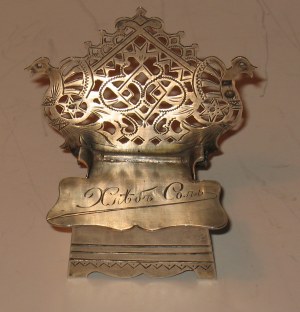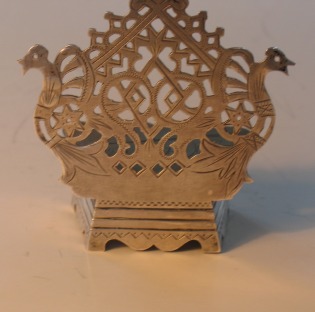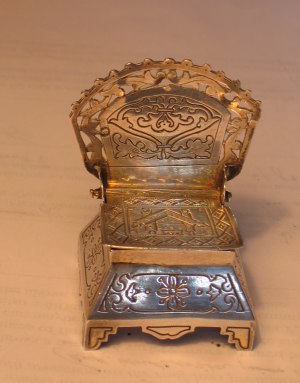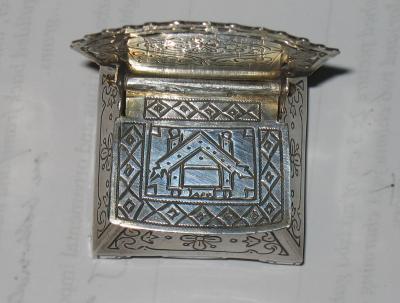by Willand
Ringborg ©
(click on photos to enlarge image)
ORNAMENTAL SHAPING OF SILVER SALT THRONES FROM RUSSIA
The salt throne or salt chair is often associated with its origin
in Russian rural life, its historicism and the
importance of its ornamental and decorative tradition. The 'izba',
the small wooden house, represented an important link to peasant
life and romanticism and had a double influence on the shaping
of salt chairs.
First and beforehand, the izba house was the idealised place for
the deep-rooted salt ceremony, to welcome guests with bread and
salt. The izba, a construction is of medieval origin, sublimates
the pre-Peter the Great period on a representation of Russian
historicism created by the nationalist-romanticist search for
the ancient Russian style. It is the image of pure Russia, still
untouched by western influence.
Secondly, the convertion of the izba and of house's
ornamentation and carving into a squared and box-shaped surface
was an excellent way to export Russian heritage inside urbanized
and westernized areas.
|
|
|
Two silver salt
thrones from Russia, late 19th century
|
The salt throne idea, although emerging from rural circumstances,
spread into the cities and was realized and refined in precious
metals by urban silversmiths. The salt throne model became a
standard repertoire of clever silversmiths, adopting innumerable
and seldom duplicated shapes. Still, the izba representation
remained important.
 |
 |
|
Salt throne by Artemi Vasilev Blochin (AB in
Latin transcription), stamped in Kostroma,
1899-1908, assay master A. Solodilkova (-1905).
84 zolotnik silver(875/000), gold gilded in the
interior salt container, height 6.4 cm, width
6.2 cm, depth 3.7 cm, weight 35 grams
|
Back of the salt throne, shaped identically
to the front. Interwoven, and almost hidden by
the floral ornament, we may see the raising of
izba's roof, two wheels and two mystic birds (roosters
with wheels in their wings and chase-worked and
over-dimensioned tail feathers, probably
protecting from un-wished spirits). An
imagination of common saw-tooth ornamental and
plating, semi-round cuts on the finial (roof-logs)
|
This salt chair (above) is of standard size, low, pretty and
showing an ornamented area as reminiscent of a peacock, fragile,
fully pierced. The salt container is hidden under the lid, and
the back of salt chairs is often over-dimensioned in so that
they are usually referred as 'thrones'.
In our example the ornament is a truly impressive work of
intricate pattern. The lid of the salt container reads 'Khleb i
Solj' (Bread and Salt) and its frame has wave-like scalloped
decoration.
But where is the izba reference?
On the right a typical variety is shown, a more squared
box and farthingale shaped.
The piercing is modest and the ornamental richness of
flowers and piercing is emphasised by the gilt back
frame.
On the topo we may deduct the stylised saw-tooth pattern
of the izba finial.
The feet show also a difference; these stair feet are
common in the Russian style, while the front frame of
the above one shows a bended frame line. |
 |
| |
Salt throne in silver, by unknown master,
initials ISL and IS (in Latin transcription), Moscow
1887, assay master Victor Savinkov. 84 zolotnik
silver, gilt back frame on both sides and inside the
salt space, height 6.01 cm, width 4.5 cm, depth 3.5
cm, weight 38 grams
|
 |
But, where should we look for the much-renowned izba
tradition and ornamental importance?
In referring so much to the izba traditions and
ornamental importance, where do we see this present?
It is not apparent at first sight, so let us have a
closer look (left) |
|
Salt throne seat with a small stylized
picture 1.5 x 2 cm of an izba gable, low raising,
with over-dimensioned finials and two chimneys. A
charming example of the izba representation and
presence in the salt ceremony memory
|
|
The salt cellars, in tsarist Russia and also thereafter, and
particularly salt chairs or salt thrones in this small shaped
size, maintain a deep-rooted tradition and a strong folklore
resemblance of rural time and rural spirit.
Willand Ringborg © - 2006 -
|
|
|
 ASSOCIATION OF SMALL COLLECTORS OF ANTIQUE SILVER
ASSOCIATION OF SMALL COLLECTORS OF ANTIQUE SILVER ASSOCIATION OF SMALL COLLECTORS OF ANTIQUE SILVER
ASSOCIATION OF SMALL COLLECTORS OF ANTIQUE SILVER